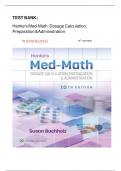.
TEST BANK;
ro
Henke's Med-Math: Dosage Calculation,
ro ro ro
Preparation &Administration
ro ro
by SUSAN BUCHHOLZ
ro ro 10TH EDITION
ro
, .
Table of Contents ro ro
Chapter 1, Arithmetic Needed for Dosage
ro ro ro ro ro
Chapter 2, Metric and Household Systems of MeasurementChapter
ro ro ro ro ro ro ro ro
3, Drug Abbreviations, Labels, and Packaging
ro ro ro ro ro ro
Chapter 4, Calculation of Oral Medications—Solids and
ro ro ro ro ro ro
LiquidsChapter 5, Liquids for Injection
ro ro ro ro ro ro
Chapter 6, Calculation of Basic IV Drip RatesChapter
ro ro ro ro ro ro ro ro
7, Special Types of IV Calculations
ro ro ro ro ro ro
Chapter 8, Dosage Problems for Infants and
ro ro ro ro ro ro
Children Chapter 9, Information Basic to
ro ro ro ro ro ro
Administering Drugs Chapter 10, Administration
ro ro ro ro ro
Procedures
ro
, .
Chapter 1, Arithmetic Needed for Dosage ro ro ro ro ro
.
Format: Multiple ro
ChoiceChapter: 1
ro ro ro
Client Needs: Physiological Integrity: Basic Care and
ro ro ro ro ro ro
ro comfortCognitive Level: ro ro r o Apply
Difficulty: r o Moderate .
Page and Header: 2, Dividing Whole Numbers; 3,
ro ro ro ro ro ro ro
ro FractionsIntegrated Process: ro ro r o Teaching/Learning
.
Objective: r o 1, 2 ro
1. A patient/client was instructed to drink 25 oz of water within 2 hours but
ro ro ro ro ro ro ro ro ro ro ro ro ro
wasonly able to drink 15 oz. What portion of the water remained?
ro ro ro ro ro ro ro ro ro ro ro ro ro
A) 2/5
B) 3/5 .
C) 2/25
D) 25/25
Ans: A .
Feedback: Subtract the quantity of water the client drank (15 oz) from the total
ro ro ro ro ro ro ro ro ro ro ro ro ro
ro available quantity (25 oz): 10 oz remain. To determine tah
ro b ie
rb.cp
oomr
/tt
eiso
t n of the water that ro ro ro ro ro ro ro ro ro ro ro ro ro ro
ro remains, create a fraction by dividing 10 oz (remaining portion) by 25 oz (total
ro ro ro ro ro ro ro ro ro ro ro ro ro
portion). Therefore, 10 divided by 25 = 10/25. To reduce fractions, find the largest
ro ro ro ro ro ro ro ro ro ro ro ro ro
.
number that can be divided evenly into the numerator and the denominator (5).
ro ro ro ro ro ro ro ro ro ro ro ro
Tendivided by 5 (10/5) = 2; 25/5 = 5. The fraction 10/25 can be reduced to its lowest
ro ro ro ro ro ro ro ro ro ro ro ro ro ro ro ro ro ro ro
terms of 2/5. ro ro
.
Format: Multiple Choice r o ro
.
Chapter: 1 ro
Client Needs: ro r o Physiological Integrity: Basic Care and Comfort ro ro ro ro ro
.
Cognitive Level: Apply ro ro
Difficulty: r o Moderate
Page and Header: 2, Dividing Whole Numbers; 3, Fractiaobin
ro ro rbs
. ro ro ro ro ro ro ro
.
Page 1 r o
, .
Integrated Process: Teaching/Learning ro ro
Objective: r o 1, 2 ro
2. A patient/client was prescribed 240 mL of Ensure by mouth and a
ro ro ro ro ro ro ro ro ro ro r o
ro supplementbut consumed only 100 mL. What portion of the Ensure remained?
ro ro ro ro ro ro ro ro ro ro ro
A) 5/12
.
B) 7/12
C) 100/240
D) 240/240 .
Ans: B
Feedback: Subtract the quantity of Ensure the client conasbiu
ro
rbm
.coe
md/tes(t100 mL) from the ro ro ro ro ro ro ro ro ro ro
ro total available quantity (240 mL): 140 mL remain. To determine the portion of the
ro ro ro ro ro ro ro ro ro ro ro ro ro
ro Ensure that remains, create a fraction by dividing 140 mL (remaining portion) by 240
ro ro ro ro ro ro ro ro ro ro ro ro ro
.
mL (total portion). Therefore, 140 divided by 240 = 7/12. To reduce fractions, find the
ro ro ro ro ro ro ro ro ro ro ro ro ro ro
largest number that can be divided evenly into the numerator and the denominator
ro ro ro ro ro ro ro ro ro ro ro ro
(20); 140 divided by 20 (140/20) = 7; 240/20 = 12. The
ro ro ro ro ro ro ro ro ro ro ro 140/240 can be ro ro
fractionreduced to its lowest terms of 7/12.
ro ro ro ro ro ro ro ro
.
Format: Multiple ro
ChoiceChapter: 1
ro ro ro
Client Needs: Physiological Integrity: Basic Care and
ro ro ro ro ro ro
ro comfortCognitive Level: ro ro r o Analyze
Difficulty: r o Difficult .
Page and Header:
ro ro r o 2, Multiplying Whole Numbers; 3,
ro ro ro ro
ro FractionsIntegrated Process: ro ro r o Communication and Documentation ro ro
.
Objective: r o 1, 2 ro
1 1
3. A patient/client consumed 2
ro ro ro
4 oz. of coffee, 2/3 oz. of ice cream, and 1
ro ro ro ro ro ro ro ro ro
2
abirb.com/test
oz.of beef broth. What is the total number of ounces consumed that should be
ro
ro ro ro ro ro ro ro ro ro ro ro ro
ro documented for the patient/client? ro ro ro
A) 3 3/4 ro .
B) 4 5/12ro
C) 4 2/3 ro
.
D) 4 4/9 ro
.
Page 2 r o




